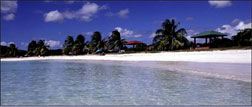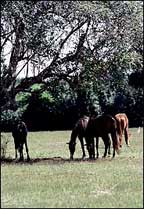|
 |
|
Esta página no está disponible en español. THE NEW YORK TIMES An Island's Ship Comes In By CLAUDIA DREIFUS March 21, 2004 PHOTOS: Laura Magruder for The New York Times
HE first time I stood in front of Camp Garcia, the Navy installation that dominated Vieques - that gorgeous tropical isle eight miles off Puerto Rico - was in January 2000. Hundreds of people, with their horses, mules, and S.U.V.'s, were picketing the military base, praying, chanting, carrying signs that read, more or less, "Navy Go Home!" For more than half a century, the United States Navy had used two-thirds of the island as a munitions depot and bombing range. Then, in 1999, a misdirected bomb killed a local man. A thousand days of demonstrations followed. In January 2003, the Pentagon agreed to a withdrawal, completed last May. On May 1, the military ceded about 15,000 acres of its land to the federal Fish and Wildlife Service. With roughly 3,100 additional acres from the western end that the Navy had transferred two years earlier, something splendid was created: the Vieques National Wildlife Refuge, one of the largest nature preserves in the Caribbean. Though about 9,000 or so acres of the refuge remain off limits while the Navy clears the land of contaminants and unexploded ordnance, large sections are already open to the public - not to mention to turtles, pelicans, lizards and about 130 types of birds. This new sanctuary is a remarkable place. In January, when my partner, Andrew, and I were again at the gates of Camp Garcia, we found that armed guards and angry protesters had been replaced by snowy egrets. Wild horses gamboled near our path. Small tropical birds could be seen feeding in the shrubbery. The land was flat, dry, reminiscent of the Arizona desert. Yet it had an edenic quality. A mile or so inside the camp were two pristine beaches open to visitors; the Navy called them Red Beach and Blue Beach (there's a Green Beach at the western end). At Blue Beach, once the scene of war games, we snorkeled with stingrays, parrotfish, even dolphins. "This island was great before, but it's really paradise now," Andrew said.
Actually it's paradise up for grabs. Vieques is facing contending futures. In the bars and bistros of the island, the No. 1 topic is, "Whither Vieques?" Will the big hotel chains come? Will the current real-estate boom push the local people out? Will Vieques lose its funky "lost in time" ambience? "This is a fantastic piece of land in a time warp," Thomas H. Wright told me. Mr. Wright is a former vice president of Princeton University who recently retired to a modern house he built in Vieques high above the Atlantic. "Everyone wants to know what will happen to the land and the people now that this protective cocoon is gone." That cocoon, for better or worse, was the Navy. So long as the military controlled most of the island, it remained underdeveloped, poor and - one hates to admit it - charming. The main town, Isabel Segunda, with its colonial buildings and slightly mildewed cafes, always seemed a bit like the Cuba that Hemingway found in the 1940's. Four years ago, I estimated that there were only 150 guest rooms on the entire island. For the kind of travelers who made their way here, the appeal was great beaches - long, empty strands of sand that open to warm azure waters full of interesting fish.
The other draw was what Vieques didn't have - McDonalds, casinos, duty-free shops. "You feel real here," said a second-time visitor, Jeffrey Alexander, a sociologist from New Haven. "You don't feel like you are being manipulated by resort culture." Burr Vail, the proprietor of our Spanish-style guesthouse, the 15-room Hacienda Tamarindo near the town of Esperanza, said that the island started changing the moment the Navy pulled out. "It was like day and night," he said at breakfast in the open-air courtyard that serves as the hacienda's dining room. "Business improved incredibly. That, in turn, has created a different mood, a big sigh of relief and a positive attitude everywhere." And a real estate boom. Speculators from New York and San Juan are buying, buying, buying. A glance through ads in El Nuevo Vieques, a monthly publication, shows houses offered for $310,000 and $450,000, prices unheard of four years ago. Mr. Vail is erecting eight villas in his back lot and asking more than a half-million dollars for each. Four have been sold already, he said. The influx of capital to Vieques has increased the number of available guest rooms markedly. We inspected and liked the recently renovated Casa La Lanchita, in the village of Bravos de Boston. This guesthouse, built into a cliff above the sea, has eight cheerful units, each with private terrace and kitchen. That kitchen really appealed. Dining out in Vieques has always been expensive and problematic. Dinner for two usually ran around $100, and was rarely worth it. Down the road from La Lanchita is the new Chef Michael's FoodSpace, a herald of gentrification and improved food choices. This elegant charcuterie-cafe offers Angus beef, French cheeses, sushi-grade fish, several types of pâtés and wine by the glass. Prices are more or less comparable to those of Dean & DeLuca in New York, which isn't that bad considering that the chef must fly his supplies in from San Juan and Boston. Chef Michael's is the centerpiece of an inn that opened last month, ¡Bravo! Each of the inn's nine minimalist rooms has the maximum in state-of-the art electronics, from the Dish Network to Wi-Fi for laptops, at $193 a night, in season. Vieques's first chain hotel, the 156-room Wyndham Martineau Bay Resort and Spa, charges higher rates. When it opened its doors last March, it instantly doubled the island's tourist capacity. It has also created more than a hundred jobs for islanders. In fact, Martineau Bay is now Vieques's largest private employer, which is why even the most militant of the Viequenses have come around to accepting it. "The jobs are good and the checks are good,'' said Ernesto Peña, a local artist and an activist against the naval base. "We wouldn't want anything bigger than that coming here, though." Martineau Bay is huge. The resort sprawls over 42 acres, with two tennis courts, a free-form swimming pool, two private beaches, a restaurants, a gift shop and a health club; all are contained by an imposing concrete wall and shut off from the rest of the island by security gates. Andrew and I checked into Martineau Bay for one night to see firsthand what a reputed $50 million investment had built. Because so many jobs were riding on the hotel's success, we rather wanted to like the place. Alas, we were mostly disappointed. On the plus side, the rooms were lovely. Our double was, I'd say, about a third larger than the standard hotel room. Decorated with blue fabrics, Mexican tiles and Philippine rattan, it had a breezy elegance. The open double bathtub was particularly fun; it was easy to watch HBO while soaking. The young staff is friendly and kind. Wherever we went, staff members smiled, offered help and asked about our day. But even with an amiable staff and stylish guest rooms, the place suffered from a blandness that left us disoriented. Once inside Martineau Bay's walls, you had no idea where you were. Was this the Bahamas? Jamaica? The swimming pool was exactly like the swimming pool at a hundred other tropical hotels. On an island known for its gorgeous breaches, Martineau Bay's private ones were small; because the hotel fronts on the Atlantic side of the island, the water was turbulent and cold. One would not take a child swimming here. The poolside restaurant menu was more food court than four-star. Andrew stared unhappily at his burned $11 hot dog. I was even unhappier at dinner in the "gourmet restaurant" with a mushroom dish that tasted as if it had been braised in milk of magnesia. Wyndham's quixotic Web site posted room rates that went all over the place for the period of time we were thinking of staying there - $287, $325, $395, $650, plus 9 percent for taxes and 11 percent for "resort fees." Suites were more, of course. Ultimately, we paid $287, using an AARP discount. With meals, including a forgettable dinner, we ran up a $541 tab in 24 hours. After we checked out, Andrew and I drove down the road to the western section of the wildlife preserve, not far from the hotel. When we'd been to Vieques in January 2000, this part of the island was so forbidden that it might as well have been on another planet; now parts have become a playground for birders, mountain bikers and joggers. After some wrong turns, we found a lagoon we'd heard about. The sun had begun to set. On the water, three squawking ducks were chasing one another's tails. Looking at this scene, one couldn't help but think that Vieques's much debated future was here, in this rich patch of land. In the overbuilt, overpopulated Caribbean, this is the treasure that will keep Vieques special. Visitor Information The Vieques National Wildlife Refuge, (787) 741-2138, southeast.fws.gov/vieques; is open 6 a.m. to 6 p.m.; free admission. Getting There From San Juan, Vieques Air Link, (888) 901-9247, www.vieques-island.com, operates 30-minute flights to the island; $151 round trip. Airlines arriving in San Juan do not transfer baggage to Vieques Air, though they don't always tell travelers. Extra time is needed in San Juan to pick up luggage and endure a second check-in. Hotels and Restaurants Room rates are for high season. The Hacienda Tamarindo, Road 996, Kilometer 4.5, Barrio Puerto Real, (787) 741-8525, fax (787) 741-3215, www.enchanted-isle.com/tamarindo, offers 15 pretty rooms and suites with private bath and a hearty breakfast for $155 to $245 a night. There's a pool on premises, but no faxes, phones or electronics in the rooms. Casa La Lanchita, 374 North Shore Road, Bravos de Boston, (800) 774-4717, fax (787) 741-5139, has a combination lap and kiddie pool, its own beach on the Atlantic, and eight utilitarian apartments at $80 to $125, with a $10 surcharge for each guest beyond two. The high-concept ¡Bravo! and Chef Michael's FoodWorks complex, 1 North Shore Road, Bravos de Boston, on the Web at www.bravobeachhotel.com, (787) 741-1128, fax (787) 741-3918, has nine rooms for $160 to $215 a night and a two-bedroom villa ($425). Double rooms at the Wyndham Martineau Bay Resort and Spa, Road 200, Kilometer 3.4, (787) 741-4100, fax (787) 741-4171, www.martineaubay.com, are $267 and up. Guests staying at Martineau Bay might consider the dinner alternative of Trópico, Road 200, Kilometer 3.0, (787) 741-4000, a restaurant that serves ribs. It is just outside the hotel's security gates. Open Wednesday to Saturday. Dinner for two, with drinks, tax and tip, came to $53 Local people who have fixed up apartments in their house offer an affordable lodging option. For example, the Bird's Nest Studio, just off Road 977 at Kilometer 1.4, (787) 487-4224, www.birdneststudio.com, $90 a day and $450 a week, sleeps four, has a full kitchen, and is two minutes from the wildlife refuge entrance. Its Web site links to other rentals. CLAUDIA DREIFUS writes frequently for The Times.
|

 Red Beach, inside Camp Garcia.
Red Beach, inside Camp Garcia. A quiet spot near Punta Arenas, Vieques.
A quiet spot near Punta Arenas, Vieques. Wild horses on the formerly restricted western area of the island.
Wild horses on the formerly restricted western area of the island.